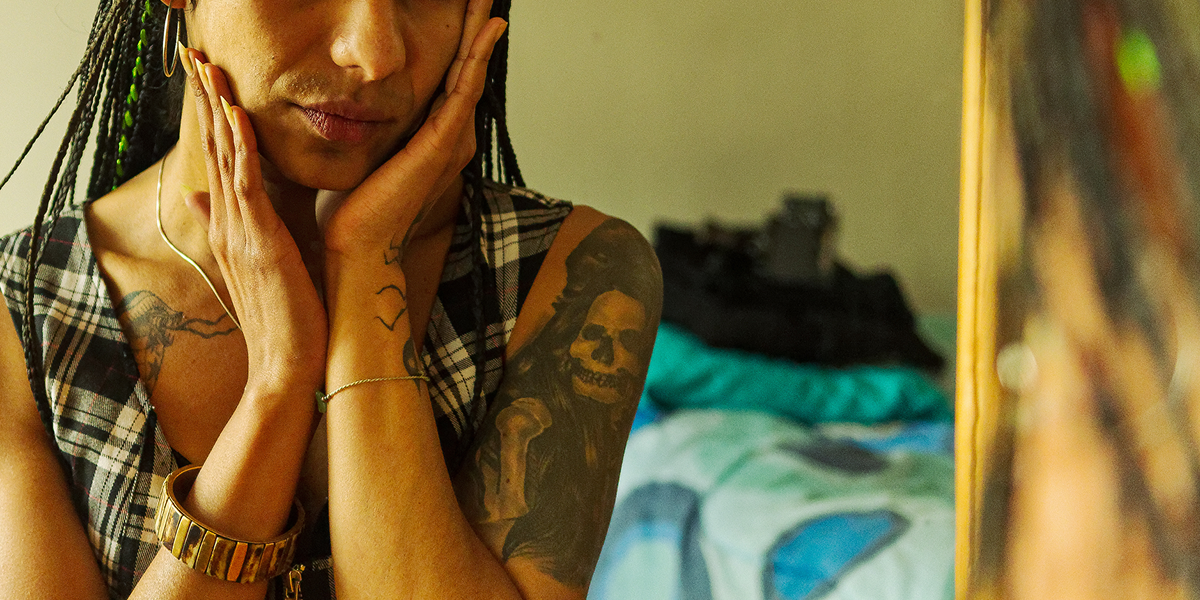Originally published by The 19th.
I’m not a morning person, but I bolted out of bed at 4:20 a.m. on November 22, 2022. The long awaited day was finally here.
When I arrived at University Hospital in San Antonio later that morning, I was asked the same question over and over: “What are you here to do today?” Each time, I was confident in my answer. I was there to evict my fallopian tubes and IUD.
Last year, in a post-Roe v. Wade Texas, I chose to have my fallopian tubes removed. The journey to that decision was the culmination of prior choices I’ve made for myself and an urgency that Dobbs v. Jackson Women’s Health Organization — the case that overturned federal abortion protections — set into motion. It was the biggest choice I could make for my body and future, because the surgery was more than a form of birth control: It was also gender-affirming care as I continued to transition away from woman to being more me — neither a boy nor a girl.
In the medical landscape, hurdles abound for trans people. Experiences of dehumanizing comments, having to educate health care professionals and their staff, intrusive questions, refusing to acknowledge a person’s gender identity or to even provide care can make it hard for trans people to pursue medical care.
When seeking medical care, trans patients face “overt discrimination, fear of discrimination and past discrimination, experiences which limit your ability to want to walk in the door,” said Dr. Clayton Alfonso, an obstetrician and gynecologist at Duke University Hospital in North Carolina. Alfonso practices full-scope obstetrics, but finds abortion and gender-affirming care to be some of the most rewarding aspects of their work.
Click an image to read captions.



“I love being a source of a safe space that someone can come in and access care in a nonjudgmental way,” Alfonso said.
But that judgment-free space is rare. One-third of respondents of the 2015 U.S. Trans Survey reported at least one negative experience in the last year related to their gender identity while seeking health care, and 23 percent did not see a doctor when they needed care for fear of mistreatment. The Trevor Project found that 1 in 3 gender diverse young people reported not feeling safe to go to the doctor or hospital when sick or injured.
– Josie NorrisAbortion care and trans care are often siloed in conversation and news stories, but there are many people, like myself, who exist in the intersection of the two.
Abortion care and trans care are often siloed in conversation and news stories, but there are many people, like myself, who exist in the intersection of the two. LGBTQ+ people who don’t identify as women but can become pregnant account for up to 16 percent of abortion patients in the country, according to a recent patient survey from the Guttmacher Institute. A 2021 study found that nearly 1 in 5 transgender, nonbinary and gender-expansive respondents who have ever been pregnant have considered ending the pregnancy without clinical supervision. A subset of those respondents, 19 percent reported attempting to end their pregnancy on their own. Reasons given ranged from structural barriers such as cost, insurance and legality of abortion to desire for privacy.





Shortly before I moved from my home state of Michigan — which last year adopted a constitutional amendment to protect reproductive rights — to San Antonio in 2018, I had an abortion. At the time I thought I was a woman, and yet being pregnant brought a sense of disconnection and betrayal that I felt in my body. I realize now that can be described as dysphoria.
I never regretted that decision I made when I was 21. I am now working as the first out transgender staff photographer at the San Antonio Express-News. Over my time in Texas, I’ve documented the state’s six-week ban in abortion — the first in the country — and near-total ban post-Roe. I’ve photographed unique stories of pregnancy and choice, including a woman grappling with the risks of continuing to try to become pregnant and a woman who had to self-manage her medication abortion at home.
Watching all of this happen around me, I knew I needed to take major steps to never be pregnant again. At the time, I’d had an intrauterine device (IUD), but no form of birth control is 100 percent effective, and IUDs pose a high risk of complications should one become pregnant while using one. I became very concerned about the lack of options for options should I somehow become pregnant.
I was not alone in this fear: Google searches for female sterilization doubled from the week after news of Dobbs was leaked in May 2022. Alfonso saw a “pretty significant” increase of requests for sterilization surgeries in both his cisgender and transgender patients, often with a sense of urgency. In the six months after Dobbs, they estimate they did 10 to 15 more sterilizations a month than before the historic legal decision. A year and a half after the overturning of Roe v. Wade, Alfonoso has seen a decrease in sterilization among cisgender patients, but is still seeing a demand among trans patients.


Growing up homeschooled and fundamental Christian, child bearing was painted for me as the epitome of womanhood. It made me uncomfortable to see child birthing scenes and scared that it was expected of me, the oldest born and assigned female at birth in my large family. Now as an adult, I’ve realized that I was a trans kid who didn’t want to be a “mommy,” despite intense external pressures. In a post-Dobbs world, imagining the gender dysphoria I would face if I became pregnant again put knots in my stomach. The idea of creating a body that was incapable of becoming pregnant felt like a step of transition away from woman.
I was not alone in this. For some of Alfonso’s gender-diverse patients, the idea of pregnancy is one of the most dysphoric and classically feminine characteristic experiences they fear.
“The number of post-op visits where people cry in my office out of just pure joy that that part of their life is finished and they can continue to move on with themselves is very rewarding,” Alfonso said.
In a post-Dobbs world, imagining the gender dysphoria I would face if I became pregnant again put knots in my stomach.
– Josie Norris
Gender-affirming care refers to a range of social, psychological and medical steps that transgender people take to express their gender that does not line up with the gender they were assigned at birth.
In the field of obstetrics and gynecology, such care is a spectrum. The gender-affirming care Alfonso provides largely centers on uterus tubes and ovaries, and whether patients want them to function or be a part of their bodies. But Alfonso also notes that gender-affirming care also includes providing pregnancy care that doesn’t assume gender in a field that is traditionally centered on cisgender women.



Going into the consultation in mid-September, my anxiety was heightened. For my first appointment, I dressed in a floral skirt to be more conventionally feminine. I was apprehensive about showing up as my full self in health care. I didn’t know how the OB-GYN, whom I’d never met, would react to my typical masc-of-center presentation. Would this provider have an issue with or ignorance about trans people? There was such a brief amount of time to make an impression on the doctor, and I didn’t have to be confusing or have to explain how I do gender. So I focused on what I could control, which is how I present myself.
We had a conversation about non-permanent birth control options, the increased risk of regret in patients under 30 and what could go wrong — which included pain, infection, internal organ damage and bleeding that could require a hysterectomy rather than just a salpingectomy, or the removal of my fallopian tubes. My ears perked up when my doctor told me that salpingectomies also may decrease risk of ovarian cancer. My OB-GYN proposed a surgery date in late November that I rushed home and put on my calendar. But still, I marked the date with a question mark. I was still afraid something would happen —that the surgery to gain control over my body would somehow be stopped.
The surgery day arrived. Up to this point, no one had asked me my pronouns, and my visit summaries misgendered me in the notes, which did not feel good. At the hospital, a resident who did ask my pronouns and made a note in my chart helped me feel seen on this momentous day. Up until that moment, I had so many other things to ask and take in that I hadn’t worked up the nerve to correct a stranger on my pronouns.
Surgery was successful, and I woke up to see the residents, who got to learn from my “great anatomy” as my doctor put it, and thanked them with tears of relief in my eyes. Looking under my gown to see my new scars, I saw a body that felt a less woman and more me.
My experience navigating medical care as an out trans person was largely positive on the whole, despite a deep fear of being misunderstood and not believed by my doctor. I felt listened to and united with my OB-GYN. I felt like we were a team. I am privileged to have access to a doctor who looked like me, listened to me and my desire to take control of my future. With entire ZIP codes of San Antonio, the second largest city in Texas, lacking access to adequate health care and medical facilities, being able to access an OB-GYN, let alone one who listened to me and trusted my decision, is not always a guarantee for those with a uterus.



Six months after my surgery, I watched and documented the Texas legislative session. Numerous bills targeted trans people, such as Senate Bill 14 — which banned gender-affirming care for minors — and Senate Bill 15, which prohibits trans athletes from competing as their gender identity. Both laws are now in effect.
I saw Texans forcibly removed from the Capitol when they showed up to advocate for trans people in the state. From the House floor, camera in hand, I heard misinformation about gender-affirming care and lawmakers reducing people to their biological parts.
The politics in legislative bodies and public statements politicians make have a profound impact on trans people, particularly young trans people. According to a poll earlier this year by the Trevor Project, 86 percent of young trans and nonbinary youth say their mental health has been negatively impacted and 55 percent reported their mental health was “very negatively” impacted by legislation targeting trans people.
Given the landscape of Texas and the attacks and attempts around the country to delegitimize trans existence, it has never been more important to share stories of the diverse and nuanced lives trans folks lead.
– Josie Norris
In Texas, the transphobic rhetoric and legislation has a direct impact on health care across the state. Days after SB 14 was approved by the House, doctors staffing Dell’s Children Medical Center in Austin, which provided services to cisgender and transgender youth, left after Attorney General Ken Paxton announced an investigation citing allegations made by conservative activist group Project Veritas. Paxton also launched a similar investigation into Houston’s Texas Children’s Hospital, the largest children’s hospital in the country, after leaked medical records of minors published by the conservative Manhattan Institute claimed gender-affirming care was being provided. Texas Children’s Hospital stopped offering hormone therapy to patients last year. After intense political pressure, GENder Education and Care, Interdisciplinary Support (GENECIS), the University of Texas Southwestern Medical Center and Children’s Medical Center Dallas, closed quietly in 2021, leaving patients without affirming care.



Given the landscape of Texas and the attacks and attempts around the country to delegitimize trans existence, it has never been more important to share stories of the diverse and nuanced lives trans folks lead. Hearing stories directly from those who have been marginalized and targeted is powerful. It expands the narratives of people who are often reduced to talking points — which I have witnessed countless times covering a range of assignments.
Trans and reproductive issues are often discussed in silos, but they both affect many. Some of the most visceral pain I’ve experienced in my life, physically and emotionally, has been related to my reproductive system. If my story can help empower someone or make them think about people in a new way, it will have been worth opening up my life in one of the most intimate moments of my life.








Comments
is there any way to make the image descriptions completely visible when clicking on photos? because every single one of them is cut off for me. thanks!
Thank you for this piece! I’m an agender person who had a salpingectomy last summer, and I definitely experienced it as gender-affirming care, though it involved switching from the midwife practice I usuaysee and who have been good about gender and pronoun stuff to OBGYNs who were less so.
I was lucky in that it was pretty easy for me to get approved because I’m 37 and have given birth to a child.
For me the most gender affirming part, though, was being able to stop taking hormonal birth control. Feeling my brain and body shift as I went off of what were effectively fake female hormoyI had ben taking for almost 2 decades has been pretty great.